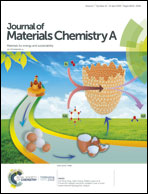Superhydrophilic Cu(OH)2 nanowire-based QCM transducer with self-healing ability for humidity detection†
Abstract
The accurate and reliable measurement of humidity is of great importance in various applications. It is challenging for researchers to pursue a humidity sensor with high performance and detection ability, especially when the device is wet. Here, we present a strategy involving the in situ growth of superhydrophilic Cu(OH)2 nanowires on a quartz crystal microbalance as a sensing layer through one-step alkali-assisted surface oxidation for the first time. The nanowires not only possessed numerous hydroxyl radicals for absorbing moisture but also exhibited superhydrophilicity, endowing the device with self-evaporation property after being wet (named as self-healing ability). We found that the Cu(OH)2 nanowire devices exhibited high sensitivity (85.9 Hz/%RH) and a rapid recovery speed (1.9 s). In particular, the devices could restore 91.8% sensitivity after being wet for 100 cycles, demonstrating excellent self-healing ability. The moisture of proximal fingertips and the mouth/nose breath of humans could be sensitively detected by the sensor, showing its potential in multifarious applications. In addition, density functional theory simulations combined with Fourier transform infrared spectroscopy experiments were carried out to study the adsorption of H2O on Cu(OH)2 surfaces, and the sensing mechanism was revealed. Our work highlights the unique advantage of superhydrophilic Cu(OH)2 nanowires for humidity detection with self-healing ability, and it also opens up a new application area for superhydrophilic materials.



 Please wait while we load your content...
Please wait while we load your content...